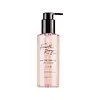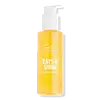What's inside
What's inside
 Key Ingredients
Key Ingredients

 Benefits
Benefits

 Concerns
Concerns

 Ingredients Side-by-side
Ingredients Side-by-side

Water
Skin ConditioningSodium Lauroyl Methyl Isethionate
CleansingGlycerin
HumectantPolysorbate 20
EmulsifyingDecyl Glucoside
CleansingCocamidopropyl Hydroxysultaine
CleansingCocamidopropyl Betaine
CleansingDisodium Laureth Sulfosuccinate
CleansingLitchi Chinensis Fruit Extract
Skin ConditioningHedychium Coronarium Root Extract
MaskingLotus Corniculatus Flower Extract
MaskingHydrolyzed Jojoba Protein
Skin ConditioningQuartz
AbrasiveRose Extract
Skin ConditioningCamellia Sinensis Leaf Extract
AntimicrobialLavandula Angustifolia Flower/Leaf/Stem Extract
MaskingCupressus Sempervirens Leaf/Stem Extract
Skin ConditioningJasminum Officinale Flower/Leaf Extract
MaskingCitrus Aurantium Bergamia Fruit Extract
Skin ConditioningCitrus Aurantium Amara Flower Extract
RefreshingMorus Indica Flower Extract
Prunus Amygdalus Dulcis Seed Extract
Skin ConditioningRosmarinus Officinalis Leaf Extract
AntimicrobialSalvia Officinalis Leaf Extract
CleansingPyrus Malus Fruit Extract
Skin ConditioningCucumis Sativus Fruit Extract
EmollientCucumis Melo Fruit Extract
Skin ConditioningCananga Odorata Flower Extract
PerfumingCoffea Arabica Leaf/Seed Extract
MaskingCucumis Melo Cantalupensis Fruit Extract
AstringentSodium Chloride
MaskingPanthenol
Skin ConditioningCaprylic/Capric Triglyceride
MaskingCocamide Mipa
EmulsifyingDisodium Lauryl Sulfosuccinate
CleansingHydroxypropyl Guar Hydroxypropyltrimonium Chloride
Trisodium EDTA
Potassium Sorbate
PreservativeCaprylyl Glycol
EmollientHexylene Glycol
EmulsifyingPhenoxyethanol
PreservativeCI 19140
Cosmetic ColorantCI 14700
Cosmetic ColorantCI 60730
Cosmetic ColorantWater, Sodium Lauroyl Methyl Isethionate, Glycerin, Polysorbate 20, Decyl Glucoside, Cocamidopropyl Hydroxysultaine, Cocamidopropyl Betaine, Disodium Laureth Sulfosuccinate, Litchi Chinensis Fruit Extract, Hedychium Coronarium Root Extract, Lotus Corniculatus Flower Extract, Hydrolyzed Jojoba Protein, Quartz, Rose Extract, Camellia Sinensis Leaf Extract, Lavandula Angustifolia Flower/Leaf/Stem Extract, Cupressus Sempervirens Leaf/Stem Extract, Jasminum Officinale Flower/Leaf Extract, Citrus Aurantium Bergamia Fruit Extract, Citrus Aurantium Amara Flower Extract, Morus Indica Flower Extract, Prunus Amygdalus Dulcis Seed Extract, Rosmarinus Officinalis Leaf Extract, Salvia Officinalis Leaf Extract, Pyrus Malus Fruit Extract, Cucumis Sativus Fruit Extract, Cucumis Melo Fruit Extract, Cananga Odorata Flower Extract, Coffea Arabica Leaf/Seed Extract, Cucumis Melo Cantalupensis Fruit Extract, Sodium Chloride, Panthenol, Caprylic/Capric Triglyceride, Cocamide Mipa, Disodium Lauryl Sulfosuccinate, Hydroxypropyl Guar Hydroxypropyltrimonium Chloride, Trisodium EDTA, Potassium Sorbate, Caprylyl Glycol, Hexylene Glycol, Phenoxyethanol, CI 19140, CI 14700, CI 60730
Water
Skin ConditioningCocamidopropyl Hydroxysultaine
CleansingPropanediol
SolventPolysorbate 20
EmulsifyingXanthan Gum
EmulsifyingDecyl Glucoside
CleansingSodium Cocoyl Glutamate
CleansingCitrus Aurantium Dulcis Peel Extract
Emulsion StabilisingCitrus Tangerina Peel Extract
AstringentPyrus Malus Fruit Extract
Skin ConditioningCitrus Paradisi Fruit Extract
Skin ConditioningCamellia Sinensis Leaf Extract
AntimicrobialCurcuma Longa Root Extract
Masking3-O-Ethyl Ascorbic Acid
Skin ConditioningVanilla Planifolia Fruit Extract
Skin ConditioningMyrciaria Dubia Fruit Extract
Skin ConditioningCocamidopropyl Betaine
CleansingPentylene Glycol
Skin ConditioningPEG-12 Dimethicone
Skin ConditioningDisodium Laureth Sulfosuccinate
CleansingDisodium Lauryl Sulfosuccinate
CleansingPolyacrylate Crosspolymer-6
Emulsion StabilisingCaprylyl Glycol
EmollientCaprylic/Capric Triglyceride
MaskingTrisodium EDTA
Hexylene Glycol
EmulsifyingEthylhexylglycerin
Skin ConditioningGlycerin
HumectantLeuconostoc/Radish Root Ferment Filtrate
AntimicrobialSodium Hydroxide
BufferingPotassium Sorbate
PreservativePhenoxyethanol
PreservativeCI 16035
Cosmetic ColorantCI 19140
Cosmetic ColorantWater, Cocamidopropyl Hydroxysultaine, Propanediol, Polysorbate 20, Xanthan Gum, Decyl Glucoside, Sodium Cocoyl Glutamate, Citrus Aurantium Dulcis Peel Extract, Citrus Tangerina Peel Extract, Pyrus Malus Fruit Extract, Citrus Paradisi Fruit Extract, Camellia Sinensis Leaf Extract, Curcuma Longa Root Extract, 3-O-Ethyl Ascorbic Acid, Vanilla Planifolia Fruit Extract, Myrciaria Dubia Fruit Extract, Cocamidopropyl Betaine, Pentylene Glycol, PEG-12 Dimethicone, Disodium Laureth Sulfosuccinate, Disodium Lauryl Sulfosuccinate, Polyacrylate Crosspolymer-6, Caprylyl Glycol, Caprylic/Capric Triglyceride, Trisodium EDTA, Hexylene Glycol, Ethylhexylglycerin, Glycerin, Leuconostoc/Radish Root Ferment Filtrate, Sodium Hydroxide, Potassium Sorbate, Phenoxyethanol, CI 16035, CI 19140
Ingredients Explained
These ingredients are found in both products.
Ingredients higher up in an ingredient list are typically present in a larger amount.
Camellia Sinensis Leaf Extract is derived from the leaves of the tea plant. Black tea, green tea, and oolong tea are all harvested from this plant.
This ingredient has many skin benefits:
This ingredient contains polyphenols, a strong antioxidant. Antioxidants help fight off molecules that damage skin cells.
On top of that, the antioxidants in green tea neutralize free-radicals from the sun. This gives the skin some extra UV protection, but should not replace sunscreen.
Many components of tea have anti-inflammatory properties.
Polyphenols and L-theanine help soothe the skin and reduce irritation. The caffeine in Camellia Sinensis Leaf Extract helps calm inflamed blood vessels.
Other compounds found in tea include: Vitamin Bs, linoleic acid, magnesium, calcium, iron, and zinc.
Research has shown both drinking Camellia Sinensis Leaf Tea and applying it to the skin can help boost skin elasticity and hydration. Studies also show using tea extract may reduce sebum, or oil, production.
Learn more about Camellia Sinensis Leaf ExtractThis ingredient is an emollient, solvent, and texture enhancer. It is considered a skin-softener by helping the skin prevent moisture loss.
It helps thicken a product's formula and makes it easier to spread by dissolving clumping compounds.
Caprylic Triglyceride is made by combining glycerin with coconut oil, forming a clear liquid.
While there is an assumption Caprylic Triglyceride can clog pores due to it being derived from coconut oil, there is no research supporting this.
Learn more about Caprylic/Capric TriglycerideCaprylyl Glycol is a humectant and emollient, meaning it attracts and preserves moisture.
It is a common ingredient in many products, especially those designed to hydrate skin. The primary benefits are retaining moisture, skin softening, and promoting a healthy skin barrier.
Though Caprylyl Glycol is an alcohol derived from fatty acids, it is not the kind that can dry out skin.
This ingredient is also used as a preservative to extend the life of products. It has slight antimicrobial properties.
Learn more about Caprylyl GlycolCI 19140 is also known as Tartrazine. Tartrazine is a synthetic dye used in cosmetics, foods, and medicine to add a yellow color.
Tartrazine is created from petroleum and is water-soluble.
Some people may experience allergies from this dye, especially asthmatics and those with an aspirin intolerance.
Learn more about CI 19140Cocamidopropyl Betaine is a fatty acid created by mixing similar compounds in coconut oil and dimethylaminopropylamine, a compound with two amino groups.
This ingredient is a surfactant and cleanser. It helps gather the dirt, pollutants, and other impurities in your skin to be washed away. It also helps thicken a product and make the texture more creamy.
Being created from coconut oil means Cocamidopropyl Betaine is hydrating for the skin.
While Cocamidopropyl Betaine was believed to be an allergen, a study from 2012 disproved this. It found two compounds in unpure Cocamidopropyl Betaine to be the irritants: aminoamide and 3-dimethylaminopropylamine. High-grade and pure Cocamidopropyl Betaine did not induce allergic reactions during this study.
Learn more about Cocamidopropyl BetaineCocamidopropyl Hydroxysultaine is a synthetic cleansing agent, though it is derived from coconut oil.
It is used to enhance the texture of products by boosting lather and thickening the texture. As a cleanser, Cocamidopropyl Hydroxysultaine is mild.
Decyl Glucoside is a glucose-based surfactant and emulsion stabilizer. It is created by reacting glucose with the fatty acids from plants.
Surfactants help clean the skin by trapping oil, sebum, and dirt to be washed away. As an emulsion stabilizer, it stabilizes the ingredients in a product by preventing them from separating.
This ingredient is biodegradable and non-toxic. This ingredient is commonly found in baby shampoos.
Decyl Glucoside is sometimes used to stabilize the UV filter Tinosorb.
Learn more about Decyl GlucosideThis ingredient is a cleansing agent, surfactant, and foam booster. It considered an alternative to traditional sulfates (Sulfosuccinate) and is allowed in "sulfate-free" products.
According to a manufacturer, this ingredient is mild and can be used in baby and bath options.
We don't have a description for Disodium Lauryl Sulfosuccinate yet.
Glycerin is already naturally found in your skin. It helps moisturize and protect your skin.
A study from 2016 found glycerin to be more effective as a humectant than AHAs and hyaluronic acid.
As a humectant, it helps the skin stay hydrated by pulling moisture to your skin. The low molecular weight of glycerin allows it to pull moisture into the deeper layers of your skin.
Hydrated skin improves your skin barrier; Your skin barrier helps protect against irritants and bacteria.
Glycerin has also been found to have antimicrobial and antiviral properties. Due to these properties, glycerin is often used in wound and burn treatments.
In cosmetics, glycerin is usually derived from plants such as soybean or palm. However, it can also be sourced from animals, such as tallow or animal fat.
This ingredient is organic, colorless, odorless, and non-toxic.
Glycerin is the name for this ingredient in American English. British English uses Glycerol/Glycerine.
Learn more about GlycerinHexylene Glycol is a surfactant. Glycols are a class of alcohols. Hexylene Glycol is a surfactant and emulsifier.
As a surfactant, Hexylene Glycol helps gather dirt and oil on your skin to be washed away.
As an emulsifier, Hexylene Glycol helps keep water and oil together. This prevents them from separating in a product. Hexylene Glycol also thins out the texture of a product by lessening viscosity.
Hexylene Glycol has a small molecular weight.
Learn more about Hexylene GlycolPhenoxyethanol is a preservative that has germicide, antimicrobial, and aromatic properties. Studies show that phenoxyethanol can prevent microbial growth. By itself, it has a scent that is similar to that of a rose.
It's often used in formulations along with Caprylyl Glycol to preserve the shelf life of products.
Polysorbate 20 is made by combining ethoxylation of sorbitan, ethylene oxide, and lauric acid. It is a mild cleansing agent, surfactant, and emulsifier.
As a surfactant, it helps collect dirt and oils for washing. Emulsifiers prevent oils and water from separating.
Polysorbate 20 also adds scent to a product. Since it is made using sorbitol, it has a sweet scent. Sorbitol can also be found in fruits such as apples and peaches.
The lauric acid used to create Polysorbate 20 is often derived from coconuts.
Polysorbate 20 may not be fungal acne safe.
Learn more about Polysorbate 20Potassium Sorbate is a preservative used to prevent yeast and mold in products. It is commonly found in both cosmetic and food products.
This ingredient comes from potassium salt derived from sorbic acid. Sorbic acid is a natural antibiotic and effective against fungus.
Both potassium sorbate and sorbic acid can be found in baked goods, cheeses, dried meats, dried fruit, ice cream, pickles, wine, yogurt, and more.
You'll often find this ingredient used with other preservatives.
Learn more about Potassium SorbatePyrus Malus Fruit Extract is extract from Apples. Apples are rich in Vitamin C, sugars, and antioxidants.
The sugar in Apples are humectants and help hydrate the skin. On top of that, apples also contain some acids, such as malic acid. These acids may have a mild exfoliating effect.
Last, the phytochemicals found in apples are strong antioxidants. These antioxidants help with anti-aging as they protect your skin cells against oxidative damage.
Learn more about Pyrus Malus Fruit ExtractWe don't have a description for Trisodium EDTA yet.
Water. It's the most common cosmetic ingredient of all. You'll usually see it at the top of ingredient lists, meaning that it makes up the largest part of the product.
So why is it so popular? Water most often acts as a solvent - this means that it helps dissolve other ingredients into the formulation.
You'll also recognize water as that liquid we all need to stay alive. If you see this, drink a glass of water. Stay hydrated!
Learn more about Water